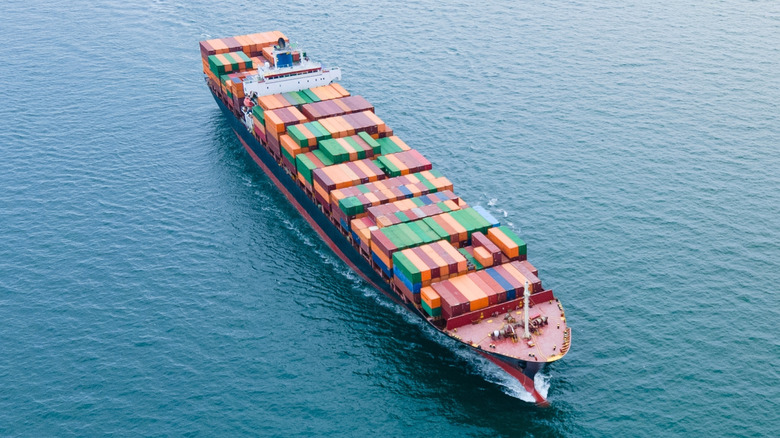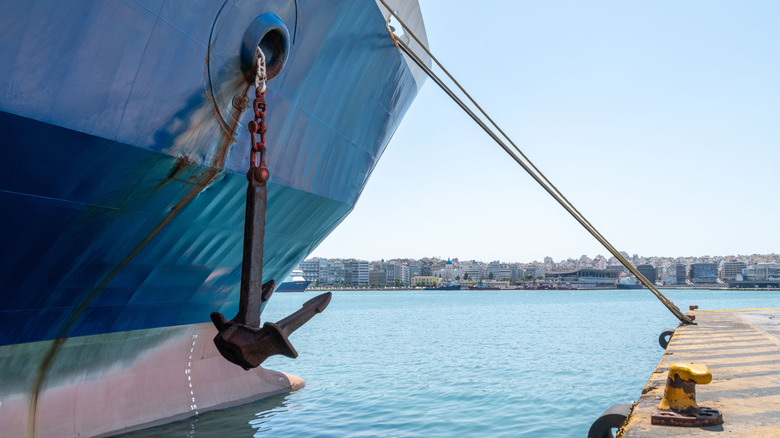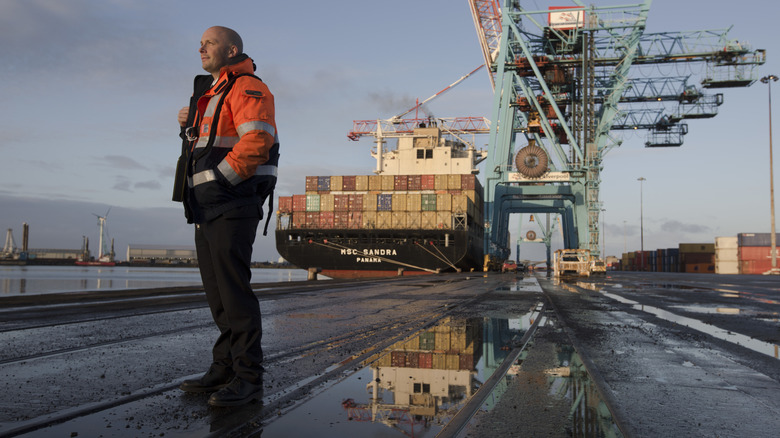How Do Ships Slow Down And Stop Without Brakes?
It's undeniable that ships are among the most impressive inventions in human history. These massive floating structures are capable of transporting goods and people across vast bodies of water, oftentimes packing in the amenities needed for folks to live somewhat comfortably throughout the journey. There are even super-specialized ships that you might not know existed. Regardless of their purpose, they can travel far, be steered, and speed up as needed. Without brakes, though, how do these oceanic marvels slow down and eventually stop?
Unsurprisingly, getting massive ships to slow down and stop isn't a small feat, nor is it done in the blink of an eye. On a typical voyage, ships travel at full sea speed until they come to a specified distance from their destination. From here, they gradually reduce speed at regular intervals while keeping the propeller on to push water over the rudder. This allows the crew to maintain some measure of control over the vessel as it moves closer to land, gradually slowing until the ship almost comes to a complete halt.
Finally, using the windlass to control the anchor's chain, the crew drops the weight shortly before the ship stops, dragging it so that it can hook into the ground below and keep the ship in place. This is standard procedure for most ships — even the strangest in the world — as they approach land. But when a ship needs to be quickly slowed and stopped in an emergency situation, other tactics are employed.
Turning under full helm and strategic rudder use
The important thing to remember about the "slowing down and stopping" method previously outlined is that it takes time. Miles and miles away from the shoreline, slowing down begins and eventually concludes once the ship reaches port. It's not perfect for every situation, specifically if there's an emergency that requires as immediate a stop as possible. This calls for other means of halting. One method is called "turning under full helm," which utilizes large bodies of water by effectively spiraling the ship inward in one direction while reducing engine power. With each turn, the ship loses speed, culminating in it returning to a similar place to where it began and coming to a full stop.
More commonly, emergencies are the time to strategically use the rudder, which is utilized for steering. Moving it from side to side repeatedly increases drag, which, along with a decrease in engine power, slows the ship down. This can be done at a high or low frequency, depending on how quickly the ship needs to stop. Low frequency creates more drag over a longer distance, so the ship's speed will reduce much faster. In a last resort situation, there are two other possibilities — a crash stop, where the engine is stopped briefly before the thrust is reversed, or an inertia stop, the complete stoppage of the engine. No matter the scenario, stopping a cruise ship isn't easy. Therefore, it's no surprise that not just anyone can handle such a task.
Stopping a ship isn't a job anyone can do
Given their size, the importance of their use, and the tedious nature of moving them around, it makes sense that not just anyone can operate a ship. Stopping them is a major task no matter which method is performed, and it's not suitable for beginners. It takes time, practice, and proper education to obtain such a job. Captain Michael Burns of the Massachusetts Maritime Academy explained as much during a chat with CBS News in March 2024, emphasizing that driving and stopping a cargo ship isn't something picked up in a day.
"It's extremely challenging, and takes years of experience and training in order to be able to do this safely," Burns explained. "It can take up to a mile for some of these ships to get stopped, depending on the circumstances, so we really need to think well out, miles ahead of the ship." The interview took place in the wake of a container ship crashing into the Francis Scott Key bridge in Baltimore, Maryland. With this in mind, Burns said that educating cadets at the Massachusetts Maritime Academy and preparing them for emergency stops is paramount to prevent such incidents (and ensure no more additions to the list of the most expensive pieces of cargo ever lost).
As necessary to the modern world as ships are, driving and stopping them isn't for the inexperienced. These are titans of the seas, after all. If the person controlling them isn't confident in their abilities, speed-induced disasters can unfold.


